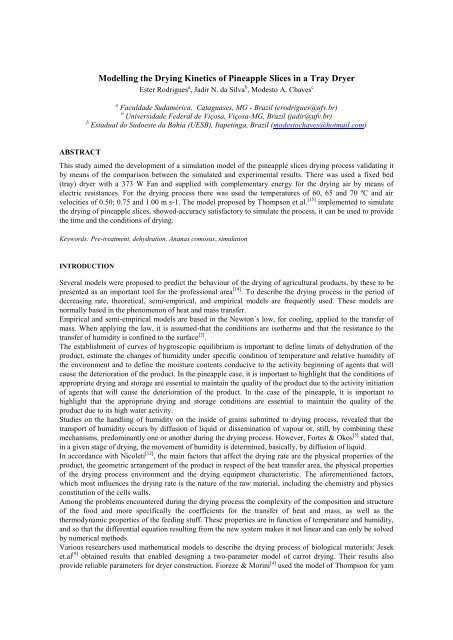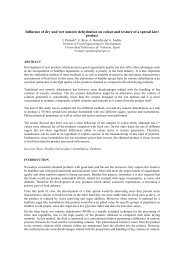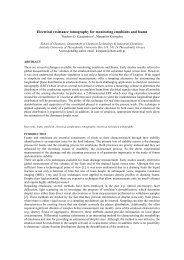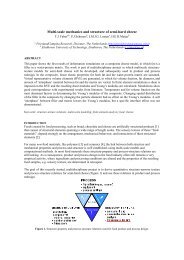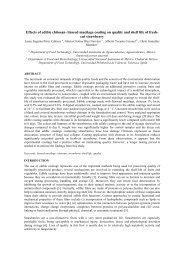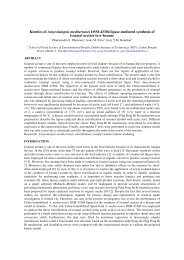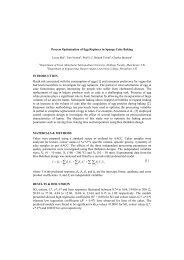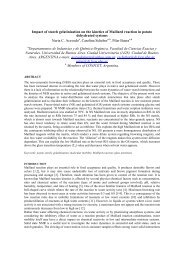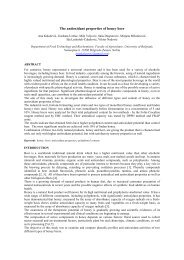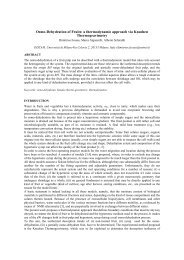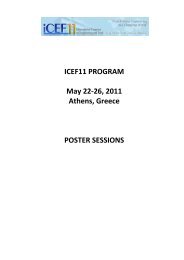Modelling the Drying Kinetics of Pineapple Slices in
Modelling the Drying Kinetics of Pineapple Slices in
Modelling the Drying Kinetics of Pineapple Slices in
You also want an ePaper? Increase the reach of your titles
YUMPU automatically turns print PDFs into web optimized ePapers that Google loves.
ABSTRACT<br />
<strong>Modell<strong>in</strong>g</strong> <strong>the</strong> <strong>Dry<strong>in</strong>g</strong> <strong>K<strong>in</strong>etics</strong> <strong>of</strong> <strong>P<strong>in</strong>eapple</strong> <strong>Slices</strong> <strong>in</strong> a Tray Dryer<br />
Ester Rodrigues a , Jadir N. da Silva b , Modesto A. Chaves c<br />
a Faculdade Sudamérica, Cataguases, MG - Brazil (erodrigues@ufv.br)<br />
b Universidade Federal de Viçosa, Viçosa-MG, Brazil (jadir@ufv.br)<br />
b Estadual do Sudoeste da Bahia (UESB), Itapet<strong>in</strong>ga, Brazil (modestochaves@hotmail.com)<br />
This study aimed <strong>the</strong> development <strong>of</strong> a simulation model <strong>of</strong> <strong>the</strong> p<strong>in</strong>eapple slices dry<strong>in</strong>g process validat<strong>in</strong>g it<br />
by means <strong>of</strong> <strong>the</strong> comparison between <strong>the</strong> simulated and experimental results. There was used a fixed bed<br />
(tray) dryer with a 373 W Fan and supplied with complementary energy for <strong>the</strong> dry<strong>in</strong>g air by means <strong>of</strong><br />
electric resistances. For <strong>the</strong> dry<strong>in</strong>g process <strong>the</strong>re was used <strong>the</strong> temperatures <strong>of</strong> 60, 65 and 70 ºC and air<br />
velocities <strong>of</strong> 0.50; 0.75 and 1.00 m s-1. The model proposed by Thompson et al. [15] implemented to simulate<br />
<strong>the</strong> dry<strong>in</strong>g <strong>of</strong> p<strong>in</strong>eapple slices, showed-accuracy satisfactory to simulate <strong>the</strong> process, it can be used to provide<br />
<strong>the</strong> time and <strong>the</strong> conditions <strong>of</strong> dry<strong>in</strong>g.<br />
Keywords: Pre-treatment, dehydration, Ananas comosus, simulation<br />
INTRODUCTION<br />
Several models were proposed to predict <strong>the</strong> behaviour <strong>of</strong> <strong>the</strong> dry<strong>in</strong>g <strong>of</strong> agricultural products, by <strong>the</strong>se to be<br />
presented as an important tool for <strong>the</strong> pr<strong>of</strong>essional area [14] . To describe <strong>the</strong> dry<strong>in</strong>g process <strong>in</strong> <strong>the</strong> period <strong>of</strong><br />
decreas<strong>in</strong>g rate, <strong>the</strong>oretical, semi-empirical, and empirical models are frequently used. These models are<br />
normally based <strong>in</strong> <strong>the</strong> phenomenon <strong>of</strong> heat and mass transfer.<br />
Empirical and semi-empirical models are based <strong>in</strong> <strong>the</strong> Newton´s low, for cool<strong>in</strong>g, applied to <strong>the</strong> transfer <strong>of</strong><br />
mass. When apply<strong>in</strong>g <strong>the</strong> law, it is assumed-that <strong>the</strong> conditions are iso<strong>the</strong>rms and that <strong>the</strong> resistance to <strong>the</strong><br />
transfer <strong>of</strong> humidity is conf<strong>in</strong>ed to <strong>the</strong> surface [2] .<br />
The establishment <strong>of</strong> curves <strong>of</strong> hygroscopic equilibrium is important to def<strong>in</strong>e limits <strong>of</strong> dehydration <strong>of</strong> <strong>the</strong><br />
product, estimate <strong>the</strong> changes <strong>of</strong> humidity under specific condition <strong>of</strong> temperature and relative humidity <strong>of</strong><br />
<strong>the</strong> environment and to def<strong>in</strong>e <strong>the</strong> moisture contents conducive to <strong>the</strong> activity beg<strong>in</strong>n<strong>in</strong>g <strong>of</strong> agents that will<br />
cause <strong>the</strong> deterioration <strong>of</strong> <strong>the</strong> product. In <strong>the</strong> p<strong>in</strong>eapple case, it is important to highlight that <strong>the</strong> conditions <strong>of</strong><br />
appropriate dry<strong>in</strong>g and storage are essential to ma<strong>in</strong>ta<strong>in</strong> <strong>the</strong> quality <strong>of</strong> <strong>the</strong> product due to <strong>the</strong> activity <strong>in</strong>itiation<br />
<strong>of</strong> agents that will cause <strong>the</strong> deterioration <strong>of</strong> <strong>the</strong> product. In <strong>the</strong> case <strong>of</strong> <strong>the</strong> p<strong>in</strong>eapple, it is important to<br />
highlight that <strong>the</strong> appropriate dry<strong>in</strong>g and storage conditions are essential to ma<strong>in</strong>ta<strong>in</strong> <strong>the</strong> quality <strong>of</strong> <strong>the</strong><br />
product due to its high water activity.<br />
Studies on <strong>the</strong> handl<strong>in</strong>g <strong>of</strong> humidity on <strong>the</strong> <strong>in</strong>side <strong>of</strong> gra<strong>in</strong>s submitted to dry<strong>in</strong>g process, revealed that <strong>the</strong><br />
transport <strong>of</strong> humidity occurs by diffusion <strong>of</strong> liquid or dissem<strong>in</strong>ation <strong>of</strong> vapour or, still, by comb<strong>in</strong><strong>in</strong>g <strong>the</strong>se<br />
mechanisms, predom<strong>in</strong>antly one or ano<strong>the</strong>r dur<strong>in</strong>g <strong>the</strong> dry<strong>in</strong>g process. However, Fortes & Okos [5] stated that,<br />
<strong>in</strong> a given stage <strong>of</strong> dry<strong>in</strong>g, <strong>the</strong> movement <strong>of</strong> humidity is determ<strong>in</strong>ed, basically, by diffusion <strong>of</strong> liquid.<br />
In accordance with Nicoleti [12] , <strong>the</strong> ma<strong>in</strong> factors that affect <strong>the</strong> dry<strong>in</strong>g rate are <strong>the</strong> physical properties <strong>of</strong> <strong>the</strong><br />
product, <strong>the</strong> geometric arrangement <strong>of</strong> <strong>the</strong> product <strong>in</strong> respect <strong>of</strong> <strong>the</strong> heat transfer area, <strong>the</strong> physical properties<br />
<strong>of</strong> <strong>the</strong> dry<strong>in</strong>g process environment and <strong>the</strong> dry<strong>in</strong>g equipment characteristic. The aforementioned factors,<br />
which most <strong>in</strong>fluences <strong>the</strong> dry<strong>in</strong>g rate is <strong>the</strong> nature <strong>of</strong> <strong>the</strong> raw material, <strong>in</strong>clud<strong>in</strong>g <strong>the</strong> chemistry and physics<br />
constitution <strong>of</strong> <strong>the</strong> cells walls.<br />
Among <strong>the</strong> problems encountered dur<strong>in</strong>g <strong>the</strong> dry<strong>in</strong>g process <strong>the</strong> complexity <strong>of</strong> <strong>the</strong> composition and structure<br />
<strong>of</strong> <strong>the</strong> food and more specifically <strong>the</strong> coefficients for <strong>the</strong> transfer <strong>of</strong> heat and mass, as well as <strong>the</strong><br />
<strong>the</strong>rmodynamic properties <strong>of</strong> <strong>the</strong> feed<strong>in</strong>g stuff. These properties are <strong>in</strong> function <strong>of</strong> temperature and humidity,<br />
and so that <strong>the</strong> differential equation result<strong>in</strong>g from <strong>the</strong> new system makes it not l<strong>in</strong>ear and can only be solved<br />
by numerical methods.<br />
Various researchers used ma<strong>the</strong>matical models to describe <strong>the</strong> dry<strong>in</strong>g process <strong>of</strong> biological materials: Jesek<br />
et.al [9] obta<strong>in</strong>ed results that enabled design<strong>in</strong>g a two-parameter model <strong>of</strong> carrot dry<strong>in</strong>g. Their results also<br />
provide reliable parameters for dryer construction. Fioreze & Mor<strong>in</strong>i [4] used <strong>the</strong> model <strong>of</strong> Thompson for yam
dry<strong>in</strong>g. Plan<strong>in</strong>ic et al. [13] used Peleg´s Model <strong>in</strong> dry<strong>in</strong>g and rehydration <strong>of</strong> carrots. Janjai et al. [8] , used a twodimensional<br />
f<strong>in</strong>ite element model to simulate moisture diffusion <strong>in</strong> mango fruit dur<strong>in</strong>g dry<strong>in</strong>g. These authors<br />
also developed a computer program <strong>in</strong> Compaq Visual FORTRAN version 6.5 was developed to simulate <strong>the</strong><br />
f<strong>in</strong>ite element model and concluded that it satisfactorily predicted <strong>the</strong> moisture diffusion dur<strong>in</strong>g dry<strong>in</strong>g<br />
The Fick model was used by Togrul & Pehlivan [16] to predict <strong>the</strong> dry<strong>in</strong>g <strong>of</strong> grape, peach, fig and plum;<br />
Hawlader et al [6] for tomatoes and Babalis & Velessiotis [2] for figs.<br />
Whereas <strong>the</strong> product conditions is dur<strong>in</strong>g <strong>the</strong> dry<strong>in</strong>g process, it was aimed with this work to implement a<br />
simulation model to predict <strong>the</strong> dry<strong>in</strong>g <strong>of</strong> p<strong>in</strong>eapple slices, validat<strong>in</strong>g it by means <strong>of</strong> compar<strong>in</strong>g both<br />
simulated and experimental results;<br />
MATERIALS & METHODS<br />
The work was carried out <strong>in</strong> <strong>the</strong> Laboratory <strong>of</strong> pre-process<strong>in</strong>g and storage <strong>of</strong> vegetable products from <strong>the</strong><br />
Department <strong>of</strong> Agricultural Eng<strong>in</strong>eer<strong>in</strong>g, Universidade Federal de Viçosa (UFV). In <strong>the</strong> dry<strong>in</strong>g process were<br />
used p<strong>in</strong>eapple fruits (Ananas comosus), Perola variety with <strong>in</strong>itial moisture content <strong>of</strong> 86 % <strong>in</strong> wet basis.<br />
The dry<strong>in</strong>g k<strong>in</strong>etics model was implemented based on <strong>the</strong> one proposed by Thompson et al. [15] . In that model,<br />
it was used, as artifice, divid<strong>in</strong>g <strong>the</strong> dry<strong>in</strong>g process <strong>in</strong> several sub processes. The bed <strong>of</strong> product was<br />
considered as formed by several layers <strong>of</strong> p<strong>in</strong>eapple-reduced thickness slices, placed on each o<strong>the</strong>r.<br />
Variations <strong>in</strong> conditions <strong>of</strong> air and slice, for each layer, were calculated based on small <strong>in</strong>crements <strong>of</strong> time.<br />
In Figure 1 is shown a diagram illustrat<strong>in</strong>g how changes occurred considered <strong>in</strong> <strong>the</strong> simulation <strong>of</strong> dry<strong>in</strong>g a<br />
reduced thickness layer, which comprises a bed <strong>of</strong> <strong>the</strong> product to be dried. When <strong>the</strong> air passes through <strong>the</strong><br />
layer, dur<strong>in</strong>g a given time <strong>in</strong>terval, a certa<strong>in</strong> quantity <strong>of</strong> water <strong>of</strong> <strong>the</strong> product is evaporated, turn<strong>in</strong>g to <strong>the</strong> air.<br />
In <strong>the</strong> <strong>in</strong>terven<strong>in</strong>g period, <strong>the</strong> air temperature decreases, as a consequence <strong>of</strong> <strong>the</strong> transfer <strong>of</strong> sensitive heat <strong>of</strong><br />
<strong>the</strong> air for heat<strong>in</strong>g <strong>the</strong> p<strong>in</strong>eapple, and <strong>the</strong> partial latent heat supplied by <strong>the</strong> product water evaporation. The<br />
quantity <strong>of</strong> water lost by <strong>the</strong> product is calculated by means <strong>of</strong> an empirical th<strong>in</strong> layer dry<strong>in</strong>g equation. F<strong>in</strong>al<br />
temperatures <strong>of</strong> <strong>the</strong> air and <strong>the</strong> p<strong>in</strong>eapple, consistent with <strong>the</strong> evaporative cool<strong>in</strong>g, are obta<strong>in</strong>ed by means <strong>of</strong><br />
<strong>the</strong> balance <strong>of</strong> energy<br />
Figure 1: Schematic draw<strong>in</strong>g <strong>of</strong> changes aris<strong>in</strong>g from <strong>the</strong> dry<strong>in</strong>g process th<strong>in</strong> layer dur<strong>in</strong>g a time <strong>in</strong>terval ∆T.<br />
In <strong>the</strong> development <strong>of</strong> <strong>the</strong> model, <strong>the</strong> follow<strong>in</strong>g assumptions were taken:<br />
a) dry<strong>in</strong>g a th<strong>in</strong> layer <strong>of</strong> <strong>the</strong> product can be described by an equation obta<strong>in</strong>ed empirically<br />
b) <strong>the</strong> temperature <strong>of</strong> slice equals <strong>the</strong> air temperature that <strong>in</strong>volves it, after <strong>the</strong> balance <strong>of</strong> energy, which<br />
take <strong>in</strong>to account <strong>the</strong> cool<strong>in</strong>g from <strong>the</strong> product water evaporation and <strong>of</strong> <strong>the</strong> temperatures <strong>of</strong> slices<br />
and air;<br />
c) <strong>the</strong> slices balance moisture content depends on <strong>the</strong> temperature and relative humidity <strong>of</strong> air <strong>in</strong> <strong>the</strong><br />
surrounds; <strong>the</strong> enthalpy <strong>of</strong> vaporization <strong>of</strong> <strong>the</strong> water <strong>in</strong> slices is constant;<br />
d) The product specific enthalpy depends on <strong>the</strong> moisture content.
To model <strong>the</strong> dry<strong>in</strong>g <strong>of</strong> <strong>the</strong> p<strong>in</strong>eapple slices layer, were used <strong>the</strong> procedures proposed by Souza et a. [14] . The<br />
follow<strong>in</strong>g steps were implemented: humidity balance calculation between <strong>the</strong> air and <strong>the</strong> product; <strong>the</strong> product<br />
humidity balance calculation; equivalent time calculation; <strong>the</strong> product humidity ratio calculation; <strong>the</strong> product<br />
humidity calculation at time t + ∆t; humidity ratio calculation; <strong>the</strong> product and <strong>the</strong> air f<strong>in</strong>al temperatures<br />
calculation; check<strong>in</strong>g <strong>the</strong> consistency <strong>of</strong> <strong>the</strong> f<strong>in</strong>al temperature and exit air mixture ratio values.<br />
For <strong>the</strong> calculation <strong>of</strong> <strong>the</strong> equilibrium temperature between <strong>the</strong> air and <strong>the</strong> product, was considered only <strong>the</strong><br />
exchange <strong>of</strong> sensitive heat. For this determ<strong>in</strong>ation, was necessary <strong>the</strong> follow<strong>in</strong>g energy balance (Equation 1).<br />
0.<br />
24 �T<br />
� W �<br />
0.<br />
24 �T<br />
� W �<br />
Where:<br />
e<br />
0<br />
�588 � 0.<br />
45 �T0<br />
� � C p � R � �1 � U ��<br />
Tg<br />
0<br />
�588 � 0.<br />
45 �Te<br />
� � C p � R � �1 � U �� Tge<br />
0 0<br />
(1)<br />
�<br />
T0 = Air temperature at <strong>the</strong> entrance <strong>of</strong> <strong>the</strong> layer <strong>of</strong> <strong>the</strong> product ºC<br />
W0= mixture ratio <strong>in</strong> air entry <strong>of</strong> <strong>the</strong> layer <strong>of</strong> <strong>the</strong> product, kg <strong>of</strong> water vapour per kg <strong>of</strong> dry air<br />
Tg0= Product temperature at time t, ºC<br />
Te= air temperature <strong>in</strong> equilibrium with <strong>the</strong> product, ºC<br />
Tge= Product temperature when it is <strong>in</strong> equilibrium with air, ºC<br />
U= Product Moisture content <strong>of</strong> <strong>the</strong> product at time t, decimal <strong>in</strong> dry basis.<br />
Cp= specific enthalpy <strong>of</strong> p<strong>in</strong>eapple, kJ kg -1 ºC -1 , and<br />
R= Mass ratio <strong>of</strong> dry matter <strong>of</strong> product layer and dry air <strong>in</strong> <strong>the</strong> time <strong>in</strong>terval �t, kg.kg -1<br />
Specific enthalpy <strong>of</strong> p<strong>in</strong>eapple was obta<strong>in</strong>ed from Mohsen<strong>in</strong> [11] as be<strong>in</strong>g <strong>of</strong> 3.6844kJ.kg -1 .�C -1 .<br />
The equilibrium temperature between <strong>the</strong> dry<strong>in</strong>g air and <strong>the</strong> product was determ<strong>in</strong>ed by Thompson et al. [15] .<br />
To calculate <strong>the</strong> product equilibrium moisture content it was necessary to determ<strong>in</strong>e primarily <strong>the</strong> air relative<br />
humidity. For this, was used <strong>the</strong> equation proposed by Brooker et al. [3] . Vapour pressure <strong>of</strong> saturated air was<br />
determ<strong>in</strong>ed us<strong>in</strong>g <strong>the</strong> equation, presented by Standard ASAE D271.2 [1] . For <strong>the</strong> calculation <strong>of</strong> moisture<br />
content <strong>in</strong> <strong>the</strong> equilibrium state was used <strong>the</strong> GAB model, with <strong>the</strong> parameters for p<strong>in</strong>eapple, obta<strong>in</strong>ed by<br />
Nicoleti [12] .<br />
Fruits <strong>of</strong> p<strong>in</strong>eapple (Ananas comosus), variety pearl, were selected given <strong>the</strong> commercial standards <strong>of</strong> quality.<br />
The fruits pre-wash<strong>in</strong>g with dr<strong>in</strong>k<strong>in</strong>g water were performed immers<strong>in</strong>g <strong>the</strong>n <strong>in</strong> chlor<strong>in</strong>ated water <strong>in</strong> a<br />
concentration <strong>of</strong> 10ppm <strong>of</strong> chlor<strong>in</strong>e, dur<strong>in</strong>g ten m<strong>in</strong>utes. The p<strong>in</strong>eapples were cut and <strong>the</strong>n sliced at<br />
approximately 0.01m and <strong>the</strong>se were cut <strong>in</strong> halves. After cutt<strong>in</strong>g, <strong>the</strong> moisture content <strong>of</strong> <strong>the</strong> product was<br />
determ<strong>in</strong>ed, <strong>in</strong> a lab oven accord<strong>in</strong>g to <strong>the</strong> Analytical Standards <strong>of</strong> <strong>the</strong> Instituto Adolfo Lutz [7] .<br />
A fixed bed (tray) dryer was used, with automatic control <strong>of</strong> <strong>the</strong> dry<strong>in</strong>g air temperature, composed <strong>of</strong> a fan<br />
(372.85 Watts), electric resistances (7500W) and tray with diameter <strong>of</strong> 0.335 m.<br />
The speed <strong>of</strong> <strong>the</strong> outlet air <strong>in</strong> <strong>the</strong> dryer was monitored by means <strong>of</strong> a <strong>the</strong>rmo anemometer and <strong>the</strong> mass <strong>of</strong> <strong>the</strong><br />
product was measured, <strong>in</strong> a digital scale, with centesimal precision, at <strong>in</strong>tervals <strong>of</strong> thirty m<strong>in</strong>utes.<br />
The air was moved perpendicularly to <strong>the</strong> direction <strong>of</strong> <strong>the</strong> tray. The moisture <strong>of</strong> <strong>the</strong> p<strong>in</strong>eapple was reduced,<br />
by means <strong>of</strong> dry<strong>in</strong>g with heated and forced air movement until a f<strong>in</strong>al moisture content <strong>of</strong> approximately 20<br />
% wet basis.<br />
<strong>Dry<strong>in</strong>g</strong> air temperatures used were 60, 65 and 70 o C and <strong>the</strong> dry<strong>in</strong>g air speed 0.5, 0.75 and 1.00 m.s -1 . Three<br />
dry<strong>in</strong>g processes were used for each treatment.<br />
To evaluate <strong>the</strong> differences between <strong>the</strong> results simulated and experimentally obta<strong>in</strong>ed, <strong>the</strong> relative average<br />
error and <strong>the</strong> determ<strong>in</strong>ation and variation coefficients were used.<br />
RESULTS & DISCUSSION<br />
Some examples <strong>of</strong> <strong>the</strong> p<strong>in</strong>eapple dry<strong>in</strong>g simulation curves, us<strong>in</strong>g <strong>the</strong> implemented model, as well as <strong>the</strong><br />
po<strong>in</strong>ts obta<strong>in</strong>ed experimentally and <strong>the</strong> correspondence between <strong>the</strong> same, are presented <strong>in</strong> Figures 2 to 11.<br />
The rates <strong>of</strong> dry<strong>in</strong>g, under <strong>the</strong> conditions <strong>of</strong> this experiment, were all approximately constant, <strong>in</strong>dicat<strong>in</strong>g that<br />
<strong>the</strong> results obta<strong>in</strong>ed are limited to this stage <strong>of</strong> <strong>the</strong> dry<strong>in</strong>g process. In general, we can f<strong>in</strong>d that <strong>the</strong> results<br />
simulated were higher than experimental ones, with <strong>the</strong> relative average error vary<strong>in</strong>g between 2.62 and<br />
11.33% and <strong>the</strong> determ<strong>in</strong>ation coefficients close to 0.99. The behaviour <strong>of</strong> <strong>the</strong> curves <strong>of</strong> simulated data<br />
represents <strong>the</strong> curve <strong>of</strong> experimental data with<strong>in</strong> <strong>the</strong> tolerable and acceptable errors limits <strong>in</strong> eng<strong>in</strong>eer<strong>in</strong>g<br />
process, consider<strong>in</strong>g <strong>the</strong> conditions under which was conducted <strong>the</strong> experiment, although with a slight<br />
tendency to underestimation.
These facts show that <strong>the</strong> simulation model developed is consistent, which could be used <strong>in</strong> <strong>the</strong> simulation <strong>of</strong><br />
dry<strong>in</strong>g p<strong>in</strong>eapple <strong>in</strong> fixed bed. The relative error average observed 7.3% is lower than 20% found by Mata &<br />
Dantas [10] and 10.9% found by Souza et al. [14] , with <strong>the</strong>se authors consider <strong>the</strong> errors obta<strong>in</strong>ed <strong>in</strong> <strong>the</strong>ir models<br />
as satisfactory.<br />
Figure 2. Moisture content observed (a) and simulated results <strong>in</strong> relation to time <strong>in</strong> p<strong>in</strong>eapple dry<strong>in</strong>g at <strong>the</strong> temperature <strong>of</strong><br />
70 o C and air velocity <strong>of</strong> 1.0 m.s -1 (b).<br />
Figure 3. Moisture content observed (a) and simulated results <strong>in</strong> relation to time <strong>in</strong> p<strong>in</strong>eapple dry<strong>in</strong>g at <strong>the</strong> temperature <strong>of</strong><br />
70 o C and air velocity <strong>of</strong> 0.75 m.s -1 (b).<br />
Figure 4. Moisture content observed (a) and simulated results <strong>in</strong> relation to time <strong>in</strong> p<strong>in</strong>eapple dry<strong>in</strong>g at <strong>the</strong> temperature <strong>of</strong><br />
65 o C and air velocity <strong>of</strong> 1.0 m.s -1 (b).
Figure 5. Moisture content observed (a) and simulated results <strong>in</strong> relation to time <strong>in</strong> p<strong>in</strong>eapple dry<strong>in</strong>g at <strong>the</strong> temperature <strong>of</strong><br />
60 o C and air velocity <strong>of</strong> 1.0 m.s -1 (b).<br />
Figure 6. Moisture content observed (a) and simulated results <strong>in</strong> relation to time <strong>in</strong> p<strong>in</strong>eapple dry<strong>in</strong>g at <strong>the</strong> temperature <strong>of</strong><br />
60 o C and air velocity <strong>of</strong> 0.75 m.s -1 (b).<br />
Figure 7. Moisture content observed (a) and simulated results <strong>in</strong> relation to time <strong>in</strong> p<strong>in</strong>eapple dry<strong>in</strong>g at <strong>the</strong> temperature <strong>of</strong><br />
60 o C and air velocity <strong>of</strong> 0.50 m.s -1 (b).<br />
CONCLUSION<br />
The ma<strong>the</strong>matical model implemented for dry<strong>in</strong>g p<strong>in</strong>eapple slices, us<strong>in</strong>g fixed bed dryer, showed to be<br />
viable, presented satisfactory accuracy and can be considered valid to simulate <strong>the</strong> dry<strong>in</strong>g <strong>of</strong> p<strong>in</strong>eapple, under<br />
<strong>the</strong> conditions <strong>of</strong> this experiment. Deserv<strong>in</strong>g, however, more detailed studies and, ma<strong>in</strong>ly for lower moisture<br />
contents.
REFERENCES<br />
[1] ASAE - American Society <strong>of</strong> Agricultural Eng<strong>in</strong>eers. 1998. ASAE Standards D271.2. St. Joseph: ASAE,. 24-31.<br />
[2] Babalis, S.J., Velessiotis, V.G. 2004. Influence conditions on <strong>the</strong> dry<strong>in</strong>g constants and moisture diffusivity dur<strong>in</strong>g <strong>the</strong><br />
th<strong>in</strong>-layer dry<strong>in</strong>g <strong>of</strong> figs. Journal <strong>of</strong> Food Eng<strong>in</strong>eer<strong>in</strong>g, 65,449-458.<br />
[3] Brooker, D.B.; Bakker-Arkema, F.W.; Hall, C.W. 1992. <strong>Dry<strong>in</strong>g</strong> and storage <strong>of</strong> gra<strong>in</strong>s and oilseeds. Westport: The<br />
AVI Publish<strong>in</strong>g Company, 450 p.<br />
[4] Fioreze, R., Mor<strong>in</strong>i, B. 2000. Yam (Discorea sp) dry<strong>in</strong>g with different cuts and temperatures: experimental and<br />
simulated results. Brazilian Journal <strong>of</strong> Food Science and Technology.20, (2), 262-266.<br />
[5] Fortes, M.; Okos, M.R. 1981. Heat and mass transfer <strong>in</strong> hygroscopic capillary extruded products. AICHE Journal, St.<br />
Joseph, 27,(2), 102-113.<br />
[6] Hawlader, M.N.A., Udd<strong>in</strong>, M.S., Ho, J.C., Teng. A.B.W. 1991. <strong>Dry<strong>in</strong>g</strong> characteristics <strong>of</strong> tomatoes. Journal <strong>of</strong> Food<br />
Eng<strong>in</strong>eer<strong>in</strong>g, 14,259-268.<br />
[7] Instituto Adolfo Lutz. 1985. Normas analíticas do Instituto Adolfo Lutz: métodos químicos e físicos para análise de<br />
alimentos. 3.ed., São Paulo, v.1, 533p.<br />
[8] Janjai, S., Lamlert, N., Intawee, P., Mahayo<strong>the</strong>e, B., Haewsungcharern, M., Bala, B.K, Muller. J. 2008. F<strong>in</strong>ite element<br />
simulation <strong>of</strong> dry<strong>in</strong>g <strong>of</strong> mango Biosystems Eng<strong>in</strong>eer<strong>in</strong>g 99 523 – 531<br />
[9] Jesek, D. Tripalo, B.Br<strong>in</strong>eie, M. Karlov, D. Vikié-Topié, D, Hercega. Z. 2006. <strong>Modell<strong>in</strong>g</strong> <strong>of</strong> Convective Carrot<br />
<strong>Dry<strong>in</strong>g</strong> Croatica Chemica Acta 79 (3) 385-391<br />
[10] Mata, M.E.R.M.C., Dantas, L.A. 1998. Modelo de simulação de secagem de cacau (Theobroma cacao L.) em<br />
camada fixa. Revista Brasileira de Armazenamento, 23,.52-60.<br />
[11] Mohsen<strong>in</strong>, N.N. 1980. Thermal properties <strong>of</strong> foods and agricultural materials. London: Gordon and Breach Science<br />
Publishers.<br />
[12] Nicoleti, J.F.; Telis-Romero, J.; Telis, V.R.N. 2001. Air-dry<strong>in</strong>g <strong>of</strong> fresh and osmotically pre-treated p<strong>in</strong>eapple slices:<br />
fixed air temperature versus fixed slice temperature dry<strong>in</strong>g k<strong>in</strong>etics. <strong>Dry<strong>in</strong>g</strong> Technology, 19(9): 2175-2191,<br />
[13] Plan<strong>in</strong>ic, M. Velic, D.Tomas, S. Bilic, M. Bucic, ´ · A. (2005) <strong>Modell<strong>in</strong>g</strong> <strong>of</strong> dry<strong>in</strong>g and rehydration <strong>of</strong> carrots us<strong>in</strong>g<br />
Peleg_s model.Eur Food Res Technol 221:446–451<br />
[14] Souza, C.M.A., Queiroz, D.M., Lacerda Filho, A.F. 2002. Simulação do processo de secagem de sementes de milho<br />
em camada fixa. Scientia Agrícola, 59,(4),653-660, Oct./Dec.<br />
[15] Thompson, T.L., Peart, R.M., Foster, G.H. 1968. Ma<strong>the</strong>matical simulation <strong>of</strong> corn dry<strong>in</strong>g. A new model. Transaction<br />
<strong>of</strong> <strong>the</strong> ASAE, 11, 582-586.<br />
[16] Togrul, I.T., Pehlivan, D. 2004. <strong>Modell<strong>in</strong>g</strong> <strong>of</strong> th<strong>in</strong> layer dry<strong>in</strong>g k<strong>in</strong>ets <strong>of</strong> some fruits under open-air sun dry<strong>in</strong>g<br />
process. Journal <strong>of</strong> Food Eng<strong>in</strong>eer<strong>in</strong>g. 65,(3), 413-425.


